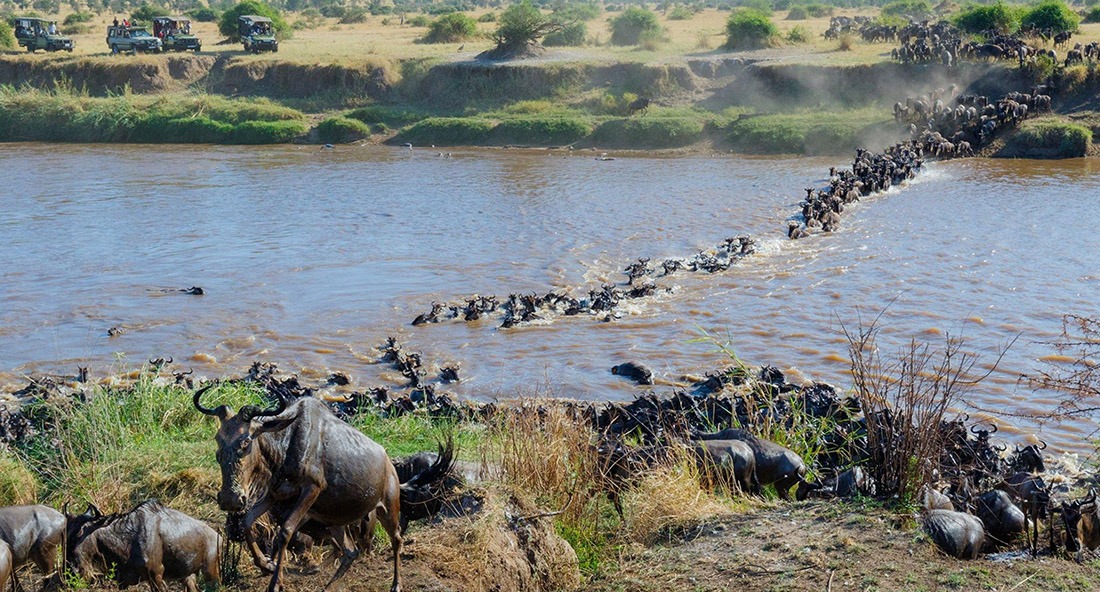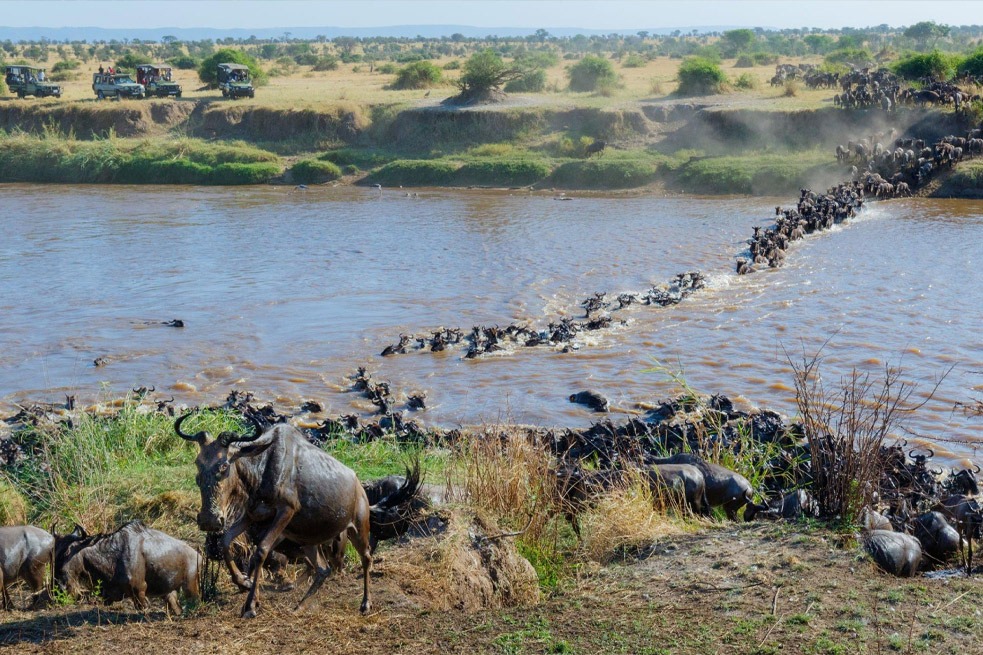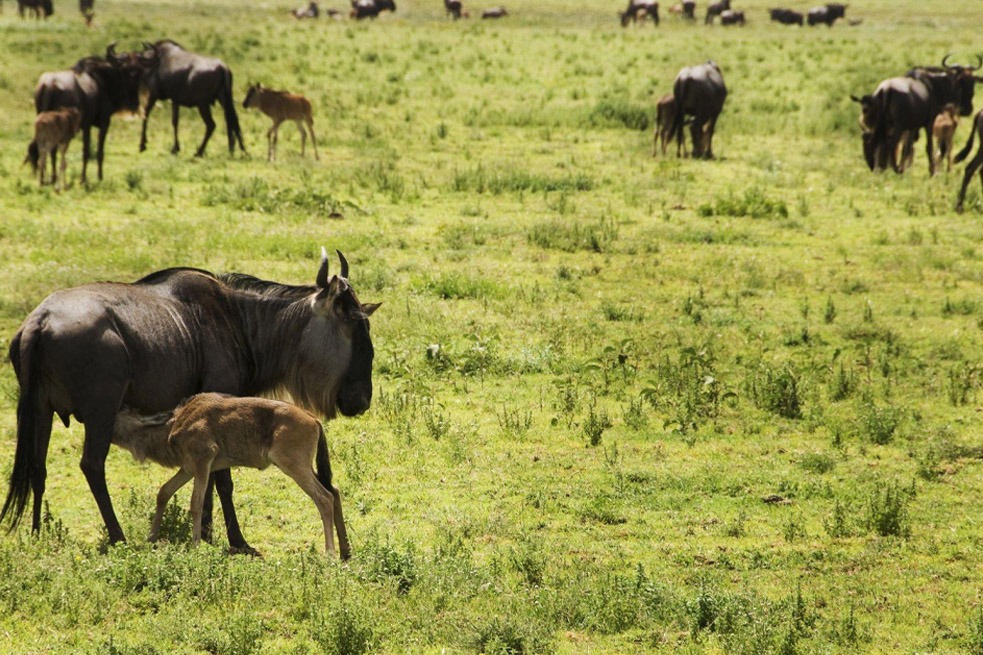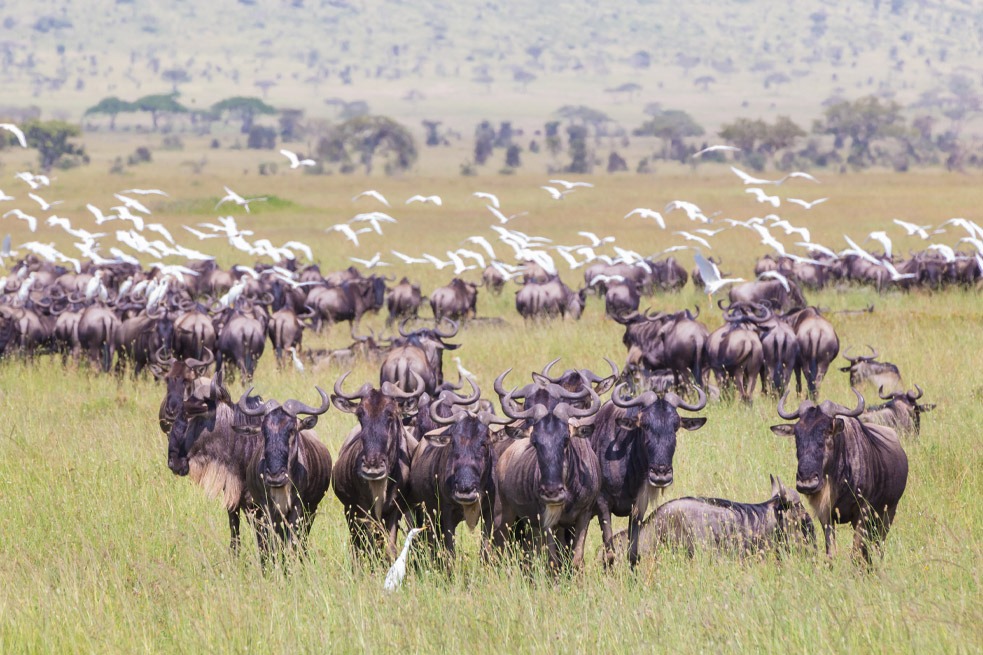Serengeti Wildebeest Migration
The most spectacular display on the planet
The Great Serengeti Wildebeest Migration
The Great Serengeti Wildebeest Migration is a stunning natural spectacle that exemplifies the circle of life. Thousands of wildebeest calves are born within a few weeks in the Southern Serengeti. Predators such as lions and hyenas constantly hunt for these babies, making it an exciting time for wildlife enthusiasts.
During the dry season in May, the herd travels north to Kenya’s Masai Mara. Here, they feed on the lush green grasslands while being surrounded by gazelles and zebras. However, the migration is not without danger, as the wildebeests have to cross rivers and face about 3,000 crocodiles waiting to attack. The largest Serengeti lion population in Africa is also a significant threat. Although prey is abundant in the area, life is challenging for these big cats in this unforgiving landscape. However, watching them collaborate to hunt down a wildebeest is a sight that will leave a lasting impression.
With the start of the short rains in late October, the migration returns to the Serengeti. By December, the herds pass Seronera, a small settlement in central Serengeti where the official Serengeti Visitors’ Centre is located, on their way back to the calving grounds, completing the circle of life.
The Great Migration is an annual event where two million ungulates, including wildebeest, zebra, Thomson’s gazelle, Grant’s gazelle, and eland, migrate through Serengeti National Park. It is considered the greatest wildlife spectacle in Africa and possibly the world. The migration follows a predictable annual cycle dictated by local rainfall patterns.
A herd of wildebeest migrating across the savanna

The Great Wildebeest Migration cycle can be divided into four periods:
December-April
During this period, the main calving grounds were in the southeast of Seronera, in the Ndutu area near Ngorongoro. The short rains in November and December triggered the wildebeest move to this area. They stay in this area until the end of the long rains, which usually happens in late April or early May. This area is easily accessible, and the landscape becomes lush during this period. February marks the calving season in the Ndutu area and southeastern plains, making it the ideal time to visit. The high number of ungulates also draws in many predators. The herd may relocate for more grazing land as early as March or April. Seeing the actual migration in this period is more complex, but you will likely encounter huge herds on the move.

May-July
Between May and July, the wildebeest prepare for their 800-kilometer-long journey after grazing on the short green grasses of southeastern Serengeti and giving birth to their young. The actual starting date is between late April and early June. This time of year is amazing because you can observe one of the most extraordinary natural occurrences in the world. You can observe more than a million animals marching in a column spanning up to 40 kilometers. This is the migration time when the herd moves towards the Western Corridor. However, the pack will face the significant challenge of crossing the Grumeti River. In the area, many oversized crocodiles pose a threat to animals attempting to cross the river. As a result, many animals do not survive the crossing. The herd may gather on the southern bank of the river and remain there for up to two weeks before attempting to cross.

August-September
During August and September, the wildebeest herd moves northwards after crossing the Grumeti River and faces another major obstacle, the Mara River. This crossing usually occurs in July or August and has been the subject of many iconic photos of the Great Migration. After this crossing, the herd flocks to Kenya’s northwest plains and Masai Mara National Reserve. According to migration patterns, about half of the pack remains in the Mara Serengeti area on the Tanzanian side. During this period, smaller groups of wildebeest cross the Mara River frequently, without any apparent reason. This is an ideal time to stay at one of the Serengeti Mara camps.

October-November
During October and November, the herd crossing the Mara River northbound needs to cross the river again before returning south. This usually occurs in October but may happen earlier. During this period, the pack will cross the northern plains and the Lobo area. This section of Serengeti National Park is little visited, so if you want to see the migration in relative quietness, this would be the time. The wildebeest returned to the short-grass plains and calving ground around Ndutu in late November, and from here, the Great Migration started all over again.
It is important to note that the outlined timings are just guidelines, as exceptions occur frequently. In November 2013, the wildebeest started migrating back to the southern Serengeti short-grass plains but was interrupted by unexpected rainfall north of the Mara River. The herd reversed course and returned to the Masai Mara region of Kenya, where it spent approximately three weeks before continuing its journey southward. Unexpected rains in the southern Serengeti in 2014 caused much of the herd to stay in the area until July instead of traveling north towards the Western Corridor.

Serengeti Wildebeest Migration and Calving Packages

Epic Grumeti River Crossing Migration Safari
9 Days | From $3,650

Explore the Wildebeest Calving Season
6 Days | From $2450
Immerse yourself in unique, unscripted experiences in the Southern Serengeti during the 6 Days Wildebeest Calving Season

Explore the Serengeti with Our Short and Sweet Safari
5 Days | From $2350
Experience the awe-inspiring Great Migration in the Serengeti with our 5-Day Migration Serengeti Safari – short, sweet, and unforgettable.

Serengeti's Big Migration Adventure
6 Days | From $2,650
